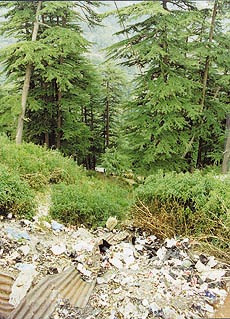 The Tribune ‘Save the
Himalayas’ campaign — V The Tribune ‘Save the
Himalayas’ campaign — V
Mountain
tops turning into garbage dumps
By
Radhakrishna Rao
FROM time immemorial, the
magnificent, snow-capped Himalayan mountain ranges have
been venerated by Indians as divinity incarnate. Apart
from the spiritual significance, the Himalayas have also
been serving as a mighty barrier against the incursion of
enemy hordes on the Indian territory from across the
border.
And, on a more practical
plane, the Himalayas exert a direct and strong influence
on the climatic pattern, hydrological cycle and soil
health of a large part of the northern and eastern India.
Because the Himalayas are
the originating point of large rivers like the Ganga,
Yamuna and the Brahmaputra, this mountain chain almost
constitutes the very lifeline of India.
However, in recent years,
an increasing number of mountaineering expeditions in
tandem with massive tourist influx have been exposing the
"clean and serene environs" of the mighty
Himalayas to the forces of pollution. Indeed, a recent
study goes to show that 33,000 kg of plastic bottles,
left behind by the climbers, have piled up in Khumbu, the
base camp leading to Mt Everest. It seems man’s
ingenuity for despoiling has touched even the highest
point in the world.
In addition, food cans,
plastic bags and other environmentally hazardous
materials left behind by the trekkers and climbers have
formed a "waste dumpyard in the highest mountain
peak of the world".
Meanwhile,
environmentalists have warned that if the Himalayan
ranges continue to be the waste pit of non-degradable
materials, it could lead to a serious ecological crisis
with disastrous consequences for the entire mountain
chain.
The Nepalese Government
has all along been requesting climbers, trekkers and
adventurers to carry back the waste materials while
descending the mountain ranges. But this seems to have
had very little impact on the climbers. Ecologists,
however, have pointed out that the Nepalese Government
has never been serious in implementing the law that
climbers should bring back the biodegradable wastes.
"This provision should be strictly monitored and an
urgent clean-up programme launched in the Everest
region," says a leading Nepalese environmental
activist.
But the Nepalese
Government has expressed its helplessness in tackling the
problem on account of the budgetary constraints.
Significantly, there has
been a steady increase in the number of expeditions to
the Himalayas over the last two decades. In fact, it was
following the relaxation of the mountain climbing rules
that India and Nepal had announced in 1975 that
mountaineering became popular. And the Himalayas have
been paying a heavy price for the popularity of
mountaineering.
The entire Himalayan chain
had suffered in terms of pollution and deforestation that
invariably follow mountaineering expeditions. As it is,
both Indian and Nepalese parts of the Himalayas are in a
bad shape. The ecological assault results in soil
erosion, flash floods and increasing aridity.
While there are reports
galore about a garbage trail along the route to the Mt
Everest, the base camp at Kanchenjunga is said to stink
beyond endurance. Even finding potable water at the base
camp at Mt Everest has become a painstaking proposition.
Obviously, deforestation
is the biggest threat that the Himalayas face from
mountaineering expeditions. Some of the expeditions take
with them up to 20 Sherpas just to fell and carry wood to
cook food and provide heat in the chilly Himalayan
environs.
Sir Edmund Hillary, who
with the Sherpa Tenzing Norgay, conquered Mt Everest in
1953 had time and again expressed concern and dismay at
the growing pollution in the Himalayas. " I am
partially to blame for this," quipped Hillary.
"The expeditions
bring in royalty to the government and employment to the
porter. But then there is a need to be on guard lest too
many expeditions pollute the pure environment of the
Himalayas", said a Nepali environmentalist.
|

